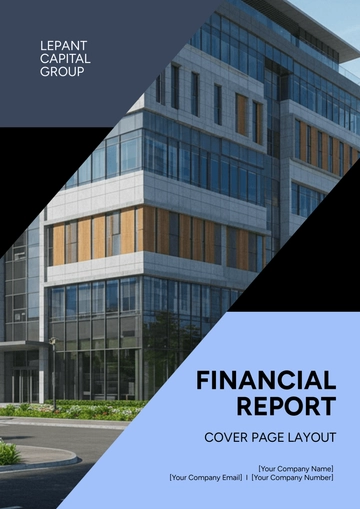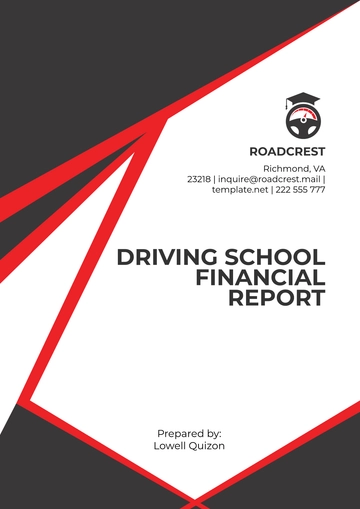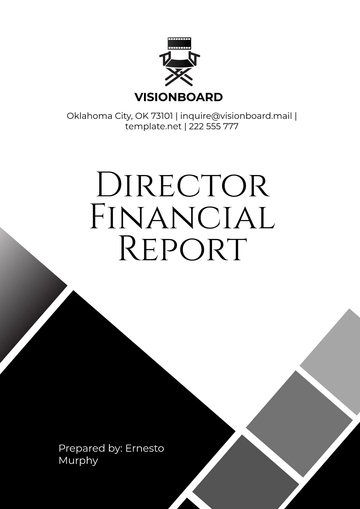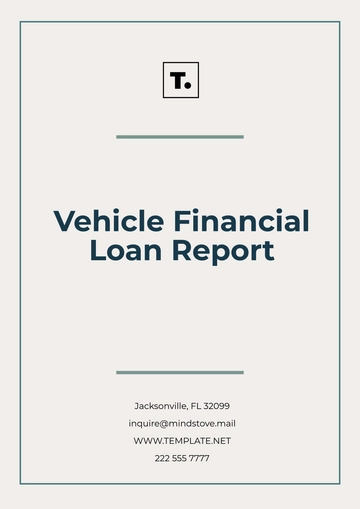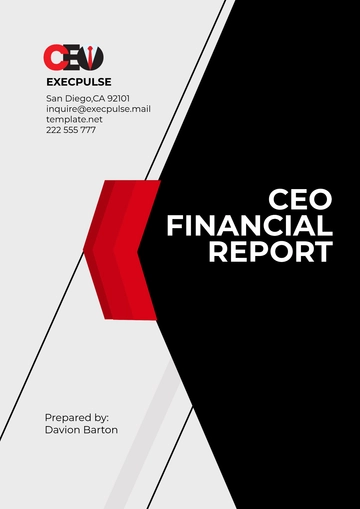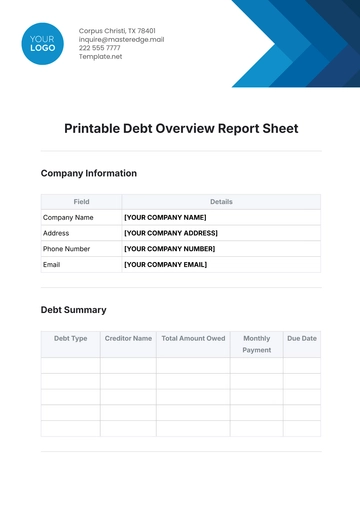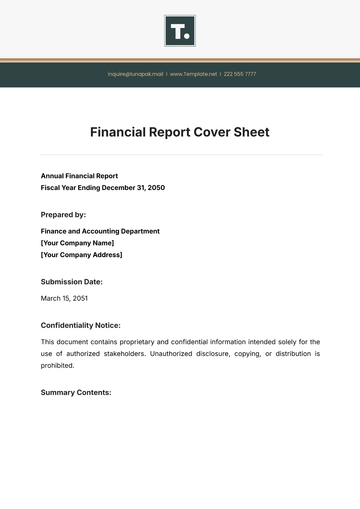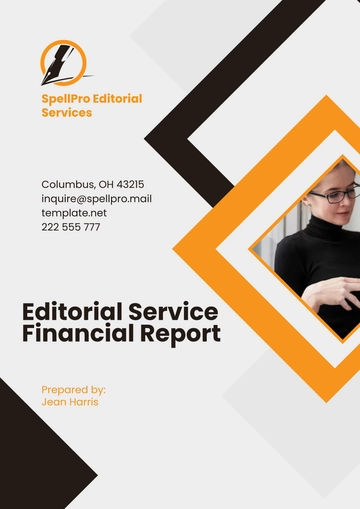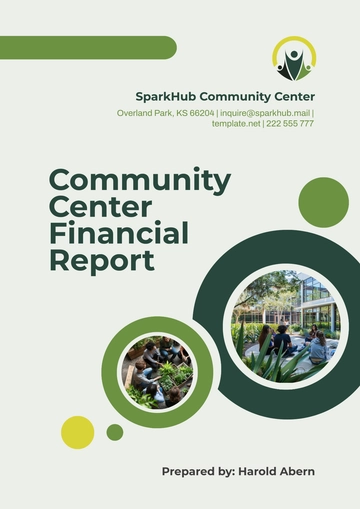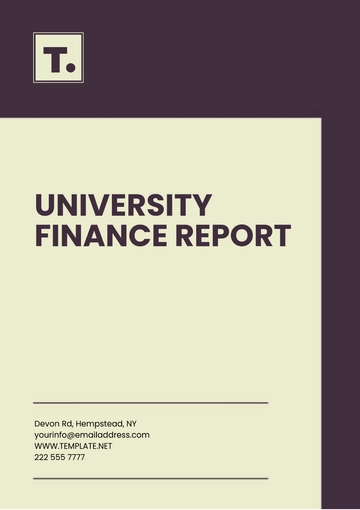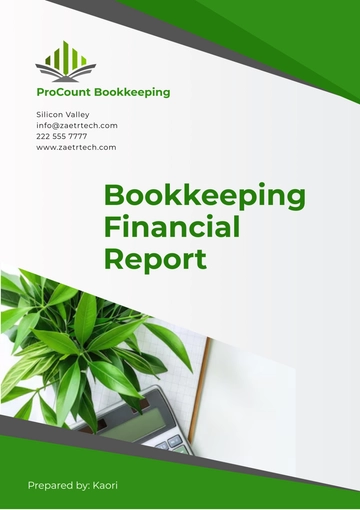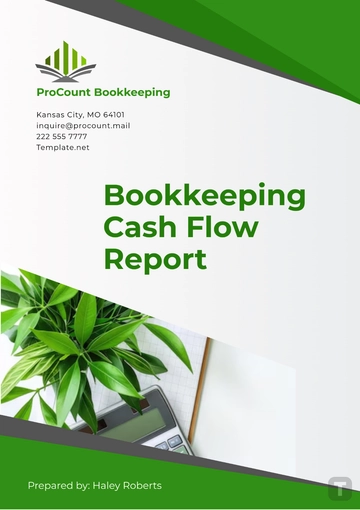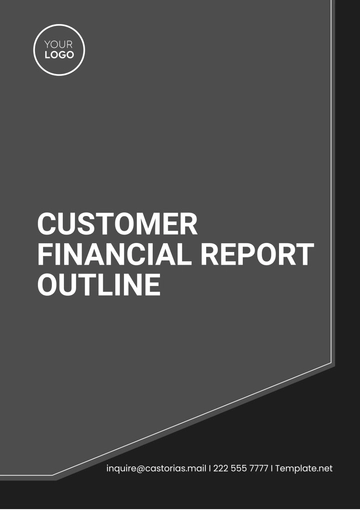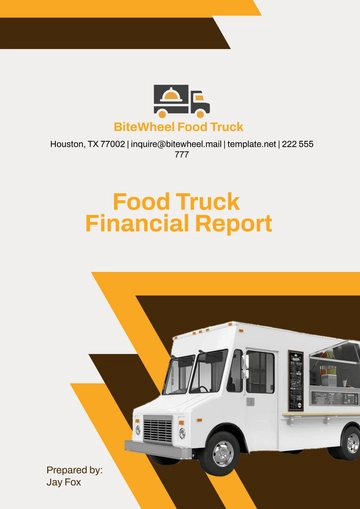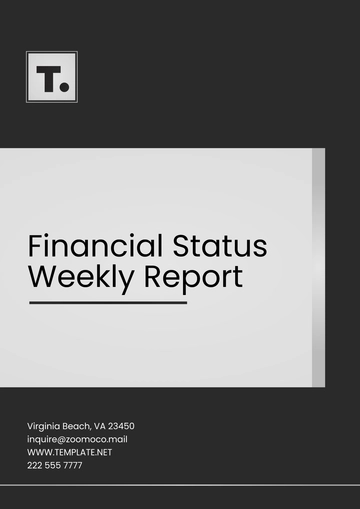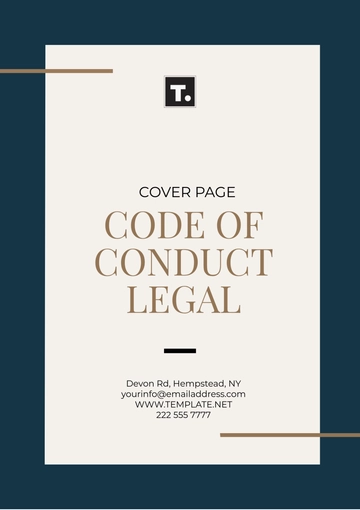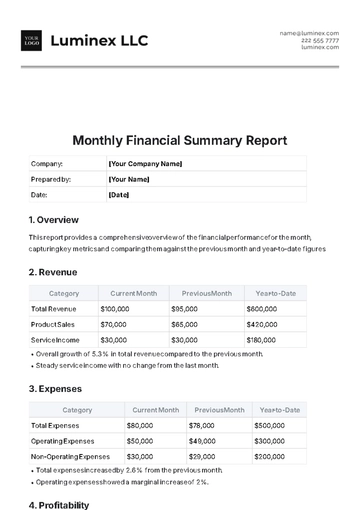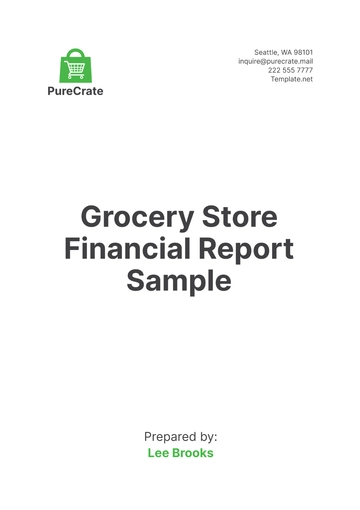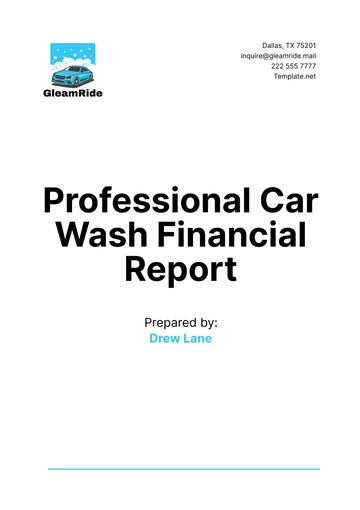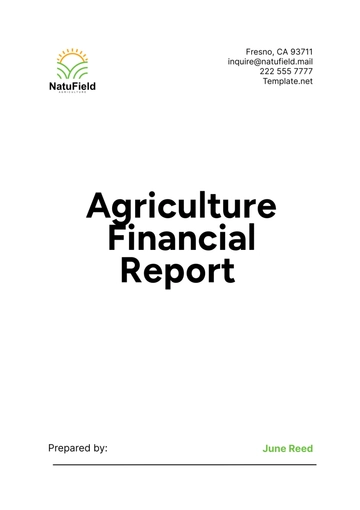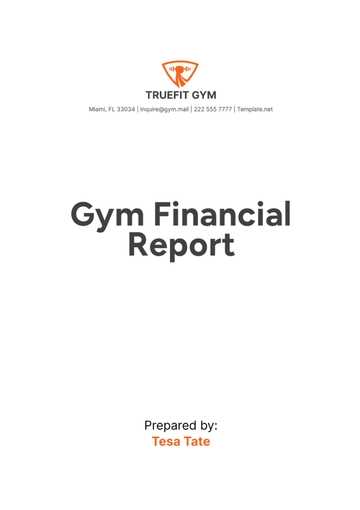Free Professional Car Wash Financial Report
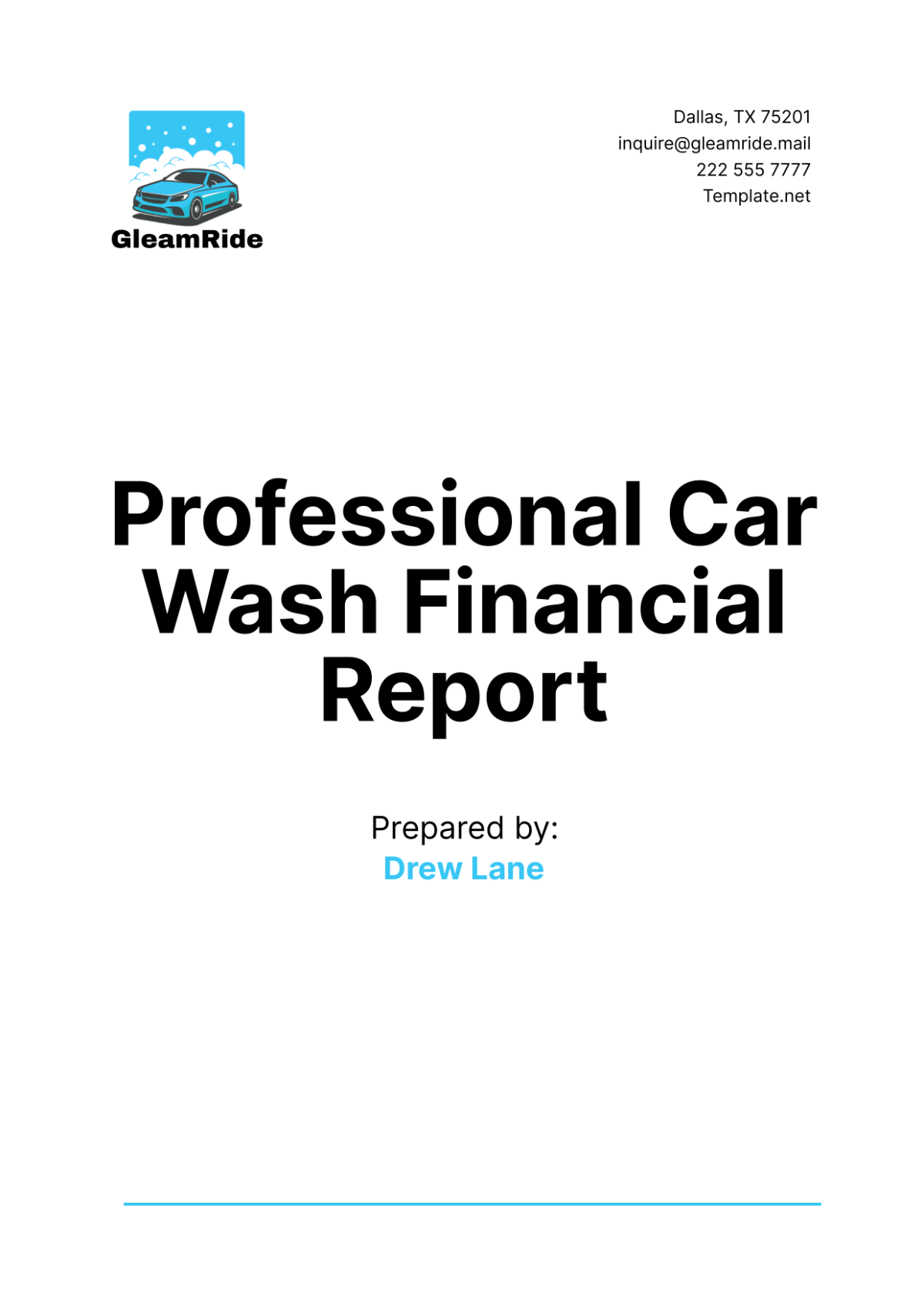
I. Executive Summary
A. Introduction
The following financial report provides a comprehensive analysis of [Your Company Name]'s financial performance for the fiscal year ending December 31, 2050. It encapsulates key metrics such as revenue growth, profitability, operating expenses, and cash flow management. This report serves as a vital tool for stakeholders, including investors, management, and regulatory bodies, to assess the company's financial health and strategic direction.
B. Key Highlights
Revenue Growth: [Your Company Name] achieved a 15% increase in total revenue compared to the previous fiscal year, driven by strategic initiatives in marketing and customer engagement. The company's diversified service offerings and competitive pricing strategies contributed to this growth.
Profit Margins: The gross profit margin of 55% underscores [Your Company Name]'s effective cost management and pricing strategies in delivering car wash services, detailing, and products. This margin reflects the balance between revenue generation and cost efficiency.
Operating Expenses: Operating expenses were maintained at 35% of total revenue, demonstrating disciplined expense management practices. Investments in employee training, energy-efficient technologies, and streamlined operational processes helped optimize these expenses.
Net Income: The net income for the fiscal year 2050 was $1,200,000, marking a substantial increase from $950,000 in the previous year. This growth in profitability reflects [Your Company Name]'s ability to leverage operational efficiencies and capitalize on market opportunities.
Customer Growth: [Your Company Name] experienced a 10% increase in new customers, driven by enhanced customer service initiatives and promotional campaigns. The expansion of loyalty programs and customer referral incentives contributed to higher customer retention rates.
C. Financial Summary
[Your Company Name]'s financial performance in 2050 showcases robust growth and stability across key financial metrics. The company's revenue diversification strategy, coupled with prudent expense management, has fortified its financial position. The balance sheet remains strong, with ample liquidity and positive cash flow, positioning [Your Company Name] for sustained growth and expansion in the competitive car wash industry.
II. Revenue Analysis
A. Revenue Breakdown
[Your Company Name] generated a total revenue of $10,000,000 in fiscal year 2050, derived from various service lines and product offerings.
Car Wash Services: The primary revenue driver, comprising basic, premium, and deluxe wash services. Basic wash services accounted for $2,500,000, while premium and deluxe services contributed $3,000,000 and $1,500,000 respectively. This segmentation reflects customer preferences for different service levels based on quality and pricing.
Detailing Services: Interior and exterior detailing services were integral to [Your Company Name]'s revenue stream, generating $1,200,000 and $1,000,000 respectively. These services cater to customers seeking comprehensive vehicle care solutions, including deep cleaning and restoration.
Car Care Products: Sales of car care products, including cleaning solutions and accessories, totaled $800,000. These products complement [Your Company Name]'s service offerings and provide additional revenue streams through retail sales and bundled service packages.
B. Revenue Growth Analysis
The 15% revenue growth in fiscal year 2050 can be attributed to several strategic initiatives:
Marketing Effectiveness: Targeted marketing campaigns leveraging digital platforms and customer segmentation strategies effectively reached and engaged the target audience. Promotional offers and discounts during peak seasons further stimulated sales.
Service Innovation: Introduction of new service packages and enhancements to existing offerings catered to evolving customer preferences. Premium upgrades and add-on services contributed to higher average transaction values and customer satisfaction.
Market Expansion: [Your Company Name] capitalized on geographic expansion opportunities, establishing new service locations and partnerships with commercial clients. This geographical diversification mitigated revenue risks and broadened the customer base.
C. Revenue Trends
Monthly revenue trends for fiscal year 2050 indicate seasonal fluctuations influenced by weather patterns, holidays, and economic factors:
Month | Revenue ($) |
|---|---|
January | 700,000 |
February | 750,000 |
March | 800,000 |
April | 850,000 |
May | 900,000 |
June | 1,200,000 |
July | 1,300,000 |
August | 1,250,000 |
September | 850,000 |
October | 800,000 |
November | 750,000 |
December | 850,000 |
Total | 10,000,000 |
Seasonal peaks in summer and holiday months correlate with increased consumer spending on vehicle maintenance and preparation. These trends inform [Your Company Name]'s seasonal staffing, inventory management, and promotional strategies to optimize revenue generation throughout the year.
III. Expenditure Analysis
A. Operating Expenses
Operating expenses for fiscal year 2050 totaled $3,500,000, representing 35% of total revenue. These expenses encompassed various operational costs essential to delivering high-quality services and maintaining customer satisfaction.
Labor Costs: Wages and salaries amounted to $1,500,000, with additional expenditures on employee benefits totaling $300,000. [Your Company Name] prioritizes competitive compensation and benefits to attract and retain skilled personnel, ensuring service excellence and operational efficiency.
Utilities: Essential utilities, including water and electricity, incurred costs of $350,000. Investments in energy-efficient technologies and conservation measures optimized resource consumption, reducing environmental impact and operational costs.
Rent: Facility rent expenses totaled $600,000, reflecting [Your Company Name]'s strategic location investments and lease agreements aligned with operational needs and customer accessibility.
Supplies: Procurement of cleaning and maintenance supplies amounted to $350,000. Bulk purchasing agreements and inventory management strategies minimized procurement costs while ensuring adequate stock levels to meet service demands.
B. Fixed vs. Variable Costs
Distinguishing between fixed and variable costs facilitates effective cost management and budgetary planning:
Fixed Costs: Non-negotiable expenses such as rent and salaries maintain stability in [Your Company Name]'s cost structure. Fixed costs are essential for sustaining day-to-day operations and supporting long-term growth objectives.
Variable Costs: Variable expenses, such as utilities and supplies, fluctuate based on service volume and seasonal demand. [Your Company Name] employs proactive cost control measures and predictive analytics to manage variable costs and enhance profitability margins.
C. Expense Management Strategies
[Your Company Name] employs proactive strategies to optimize operational expenses and enhance financial performance:
Energy Efficiency Initiatives: Implementation of LED lighting and energy-efficient equipment reduced electricity consumption by 15%, resulting in annual savings of $50,000. This sustainable practice aligns with corporate social responsibility goals while lowering operational expenses.
Supplier Negotiations: Negotiating favorable terms with suppliers and vendors for bulk purchases of cleaning supplies and equipment parts yielded a 10% reduction in procurement costs. Strategic alliances and supplier partnerships enhance cost competitiveness and supply chain resilience.
Staff Training and Development: Continuous professional development programs and cross-training initiatives improved workforce productivity and service delivery. Employee engagement surveys and performance metrics inform targeted training modules, fostering a culture of continuous improvement and operational excellence.
IV. Profitability Analysis
A. Gross Profit Margin
The gross profit margin of 55% in fiscal year 2050 underscores [Your Company Name]'s ability to generate revenue while effectively managing direct costs associated with service delivery. This margin reflects competitive pricing strategies and operational efficiencies across service lines.
B. Net Profit Margin
The net profit margin for fiscal year 2050 was 12%, a notable increase from the previous year's 10%. This improvement demonstrates [Your Company Name]'s successful implementation of cost containment measures and revenue growth strategies, enhancing overall profitability.
C. Return on Investment (ROI)
The ROI for fiscal year 2050 was calculated at 20%, reflecting [Your Company Name]'s effective allocation of resources and strategic investments in facility upgrades, marketing campaigns, and employee training initiatives. This metric illustrates the profitability of capital investments and operational expenditures relative to financial performance.
D. Comparative Profitability Analysis
Benchmarking [Your Company Name]'s profitability metrics against industry standards provides valuable insights into competitive positioning and financial health:
Metric | [Your Company Name] | Industry Average |
|---|---|---|
Gross Profit Margin | 55% | 50% |
Net Profit Margin | 12% | 8% |
ROI | 20% | 15% |
[Your Company Name]'s above-average performance in gross and net profit margins underscores its operational efficiency and market competitiveness. The ROI metric highlights [Your Company Name]'s ability to generate returns on invested capital, surpassing industry benchmarks and sustaining long-term financial viability.
V. Cash Flow Analysis
A. Cash Flow Statement
The cash flow statement for fiscal year 2050 provides a comprehensive overview of [Your Company Name]'s cash inflows and outflows from operating, investing, and financing activities:
Operating Activities: Net cash inflows from operating activities totaled $4,000,000, reflecting efficient cash management and profitability. Cash receipts from customer payments and cash disbursements for operational expenses are documented to assess liquidity and working capital adequacy.
Investing Activities: Cash outflows of $1,000,000 were attributed to investments in new equipment and facility upgrades. Capital expenditures support service innovation and operational capacity enhancements, ensuring [Your Company Name]'s competitiveness and service quality standards.
Financing Activities: Net cash inflows of $200,000 resulted from a new loan obtained and loan repayments made during fiscal year 2050. Financing activities impact [Your Company Name]'s capital structure and financial flexibility, influencing strategic decisions regarding debt management and equity financing.
Activity | Cash Inflows ($) | Cash Outflows ($) | Net Cash ($) |
|---|---|---|---|
Operating Activities | 10,000,000 | 6,000,000 | 4,000,000 |
Investing Activities | 0 | 1,000,000 | -1,000,000 |
Financing Activities | 500,000 | 300,000 | 200,000 |
Total | 10,500,000 | 7,300,000 | 3,200,000 |
B. Cash Flow Trends
Cash flow trends in fiscal year 2050 highlight [Your Company Name]'s ability to generate positive net cash flow from operating activities throughout the year. Seasonal variations in cash flows align with revenue cycles and operational expenditures, informing cash flow forecasting and liquidity management strategies.
C. Cash Flow Management
To optimize cash flow and maintain financial resilience, [Your Company Name] implements proactive cash flow management strategies:
Working Capital Optimization: Monitoring accounts receivable and accounts payable turnover ratios enhances liquidity and working capital efficiency. Timely invoicing and payment collections mitigate cash flow gaps and support operational continuity.
Capital Expenditure Planning: Prioritizing capital expenditures based on strategic priorities and ROI analysis ensures prudent allocation of financial resources. Planned investments in technology upgrades and facility expansions align with long-term growth objectives and market demand dynamics.
Debt and Equity Management: Balancing debt repayment schedules with equity financing options sustains [Your Company Name]'s capital structure and financial flexibility. Negotiating favorable terms for loans and credit facilities mitigates interest rate risks and supports sustainable growth initiatives.
VI. Balance Sheet Analysis
A. Assets
The balance sheet as of December 31, 2050, reflects [Your Company Name]'s financial position and asset base, comprising current assets, fixed assets, and intangible assets:
Current Assets: Totaling $4,000,000, current assets include cash and cash equivalents, accounts receivable, and inventory. These liquid assets support daily operations and short-term financial obligations, ensuring liquidity and operational resilience.
Fixed Assets: Property, plant, and equipment valued at $3,000,000 represent [Your Company Name]'s infrastructure investments and operational capacity. Depreciation schedules and asset maintenance programs sustain asset value and operational efficiency.
Intangible Assets: Intangible assets such as goodwill and intellectual property rights are valued at $1,000,000, reflecting [Your Company Name]'s brand equity and market reputation. These assets contribute to long-term business value and competitive advantage.
B. Liabilities
The liabilities section of the balance sheet outlines [Your Company Name]'s financial obligations, encompassing current liabilities and long-term liabilities:
Current Liabilities: Amounting to $1,500,000, current liabilities include accounts payable, short-term debt, and accrued expenses. These obligations are essential for managing day-to-day operational costs and supplier relationships.
Long-term Liabilities: Long-term debt of $1,500,000 represents [Your Company Name]'s strategic financing initiatives and capital investments. Structured debt repayment schedules and interest rate management strategies optimize financial leverage and debt service capabilities.
C. Equity
Equity reflects [Your Company Name]'s ownership structure and retained earnings, illustrating shareholder value and financial performance:
Retained Earnings: Accumulated retained earnings of $2,000,000 demonstrate [Your Company Name]'s profitability and reinvestment of earnings into business expansion and operational enhancements.
Shareholder Equity: Totaling $5,000,000, shareholder equity represents the residual value of assets after deducting liabilities. Shareholder equity metrics inform investor confidence and financial stability assessments, supporting strategic growth initiatives and capital market engagements.
D. Financial Ratios
Key financial ratios derived from the balance sheet provide insights into [Your Company Name]'s financial health and performance metrics:
Current Ratio: Calculated at 4.0, the current ratio assesses [Your Company Name]'s ability to meet short-term financial obligations with available current assets. A higher current ratio indicates strong liquidity and operational resilience.
Debt-to-Equity Ratio: With a ratio of 0.6, [Your Company Name] maintains a balanced capital structure with moderate leverage levels. This ratio benchmarks debt financing against equity investments, influencing financial risk management and capital allocation decisions.
Return on Assets (ROA): ROA of 15% measures [Your Company Name]'s profitability relative to total asset investments. This metric evaluates asset efficiency and operational performance, guiding resource allocation and investment strategies.
Return on Equity (ROE): ROE of 24% quantifies [Your Company Name]'s profitability from shareholder equity contributions. This ratio benchmarks financial returns against equity investments, demonstrating shareholder value creation and management effectiveness.
Metric | Value |
|---|---|
Current Ratio | 4.0 |
Debt-to-Equity Ratio | 0.6 |
Return on Assets (ROA) | 15% |
Return on Equity (ROE) | 24% |
[Your Company Name]'s strong financial ratios underscore operational efficiency, liquidity management, and investor confidence. These metrics validate [Your Company Name]'s financial stability and strategic alignment with industry benchmarks and competitive standards.
VII. Financial Projections
A. Revenue Projections
For fiscal year 2051, [Your Company Name] forecasts a 10% increase in total revenue, reaching $11,000,000. Revenue projections are informed by market trends, customer demand dynamics, and strategic growth initiatives:
Projected Revenue: Expected to grow to $11,000,000, driven by continued expansion in car wash services, detailing packages, and car care product sales. [Your Company Name] anticipates leveraging brand equity and customer loyalty to sustain revenue growth momentum.
B. Expense Projections
Operating expenses for fiscal year 2051 are projected to increase by 8%, totaling $3,780,000. These projections account for inflationary pressures, wage increases, and investments in technology and service quality enhancements:
Projected Operating Expenses: Estimated at $3,780,000, encompassing labor costs, utilities, rent, and supplies. [Your Company Name]'s proactive cost management strategies aim to mitigate expense escalation while supporting revenue growth objectives.
C. Profitability Projections
[Your Company Name] anticipates maintaining a net profit margin of 12% in fiscal year 2051, aligning with strategic cost containment measures and revenue diversification strategies. The projected net income of $1,320,000 underscores [Your Company Name]'s commitment to sustainable profitability and operational excellence.
D. Cash Flow Projections
Cash flow projections for fiscal year 2051 forecast positive net cash flow from operating activities, essential for supporting business expansion and capital investment plans:
Projected Net Cash from Operating Activities: Expected to reach $4,400,000, driven by efficient cash management and revenue growth initiatives. [Your Company Name]'s cash flow projections facilitate liquidity planning and strategic resource allocation for sustainable business growth.
Projected Net Cash from Investing Activities: Planned investments of -$1,200,000 in facility upgrades and technology enhancements support operational efficiency and customer service excellence.
Projected Net Cash from Financing Activities: Anticipated net cash inflows of $300,000 from financing activities, reflecting prudent debt management and capital structure optimization strategies.
VIII. Conclusion
A. Summary of Findings
The financial performance of [Your Company Name] in fiscal year 2050 reflects resilience, growth, and strategic alignment with market opportunities. Key highlights include revenue expansion, profitability enhancement, operational efficiency gains, and robust cash flow management. [Your Company Name]'s commitment to customer satisfaction, innovation, and sustainable business practices positions the company for continued success in the competitive car wash industry.
B. Recommendations
To sustain financial performance and capitalize on growth opportunities, [Your Company Name] proposes the following strategic recommendations:
Service Innovation: Introduce new car wash services and detailing packages tailored to customer preferences and market trends. Innovation in service offerings enhances customer value proposition and drives revenue growth.
Market Expansion: Explore new geographic markets and commercial partnerships to broaden customer reach and market penetration. Strategic expansion initiatives mitigate revenue risks and diversify customer demographics.
Technology Integration: Invest in advanced technology solutions for operational efficiency, customer relationship management, and data analytics. Technology adoption enhances service quality, business agility, and competitive differentiation.
C. Future Outlook
Looking ahead, [Your Company Name] remains optimistic about future growth prospects and financial performance. Strategic initiatives in revenue diversification, expense management, and capital investment will fortify [Your Company Name]'s market position and shareholder value. Continued commitment to operational excellence, customer-centricity, and innovation will drive sustainable growth and profitability in the evolving car wash industry landscape.
- 100% Customizable, free editor
- Access 1 Million+ Templates, photo’s & graphics
- Download or share as a template
- Click and replace photos, graphics, text, backgrounds
- Resize, crop, AI write & more
- Access advanced editor
Present financial data professionally with the Professional Car Wash Financial Report Template from Template.net. This editable tool ensures detailed analysis. Use our Ai Editor Tool to compile financial reports, providing clear insights into your car wash business's financial health and performance.
You may also like
- Sales Report
- Daily Report
- Project Report
- Business Report
- Weekly Report
- Incident Report
- Annual Report
- Report Layout
- Report Design
- Progress Report
- Marketing Report
- Company Report
- Monthly Report
- Audit Report
- Status Report
- School Report
- Reports Hr
- Management Report
- Project Status Report
- Handover Report
- Health And Safety Report
- Restaurant Report
- Construction Report
- Research Report
- Evaluation Report
- Investigation Report
- Employee Report
- Advertising Report
- Weekly Status Report
- Project Management Report
- Finance Report
- Service Report
- Technical Report
- Meeting Report
- Quarterly Report
- Inspection Report
- Medical Report
- Test Report
- Summary Report
- Inventory Report
- Valuation Report
- Operations Report
- Payroll Report
- Training Report
- Job Report
- Case Report
- Performance Report
- Board Report
- Internal Audit Report
- Student Report
- Monthly Management Report
- Small Business Report
- Accident Report
- Call Center Report
- Activity Report
- IT and Software Report
- Internship Report
- Visit Report
- Product Report
- Book Report
- Property Report
- Recruitment Report
- University Report
- Event Report
- SEO Report
- Conference Report
- Narrative Report
- Nursing Home Report
- Preschool Report
- Call Report
- Customer Report
- Employee Incident Report
- Accomplishment Report
- Social Media Report
- Work From Home Report
- Security Report
- Damage Report
- Quality Report
- Internal Report
- Nurse Report
- Real Estate Report
- Hotel Report
- Equipment Report
- Credit Report
- Field Report
- Non Profit Report
- Maintenance Report
- News Report
- Survey Report
- Executive Report
- Law Firm Report
- Advertising Agency Report
- Interior Design Report
- Travel Agency Report
- Stock Report
- Salon Report
- Bug Report
- Workplace Report
- Action Report
- Investor Report
- Cleaning Services Report
- Consulting Report
- Freelancer Report
- Site Visit Report
- Trip Report
- Classroom Observation Report
- Vehicle Report
- Final Report
- Software Report
